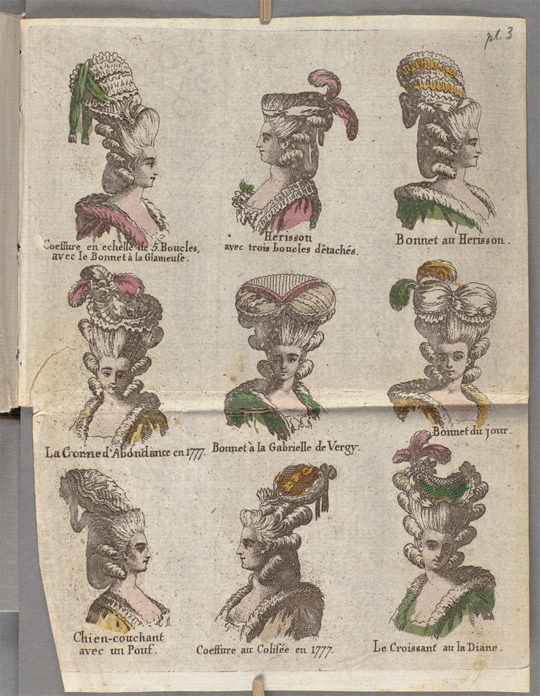 Johan Snack: ‘Nine French Hairdresses,’ 1781, in: Candid, Coeffurer, Stockholm, 1781. Image: National Library of Sweden.
Johan Snack: ‘Nine French Hairdresses,’ 1781, in: Candid, Coeffurer, Stockholm, 1781. Image: National Library of Sweden.
The current issue of Journal of Art History (Konsthistorisk Tidskrift) is a special issue on “Fashion and Print Culture: Translation and Transformation”, with Professor Peter Mc Neil and ADHT Visiting Scholar Patrik Steorn (Centre for Fashion Studies, Stockholm University) as guest editors.
From the editorial: “Print itself is both a materiality as well as a vehicle of representation. How did the meaning of various forms of fashion-relatedprints change as they were circulated in new contexts? What was the relationship of ‘fashion words’ and images? What were the mechanisms through which print – as newsprint, almanac, trade-card, respectful or satirical image – supported or undermined the spread of fashions, from ‘head-piece’ to ‘borders’? A pluralistic perspective is needed to better understand the transmission of ideas about fashion in print as well as in practice – and their interrelationship for the new readers and viewers of the period from the renaissance to the eighteenth century. This theme issue of Konsthistorisk tidskrift publishes some of the findings related to the Humanities in the European Research Area (HERA)/European Science Foundation funded project ‘Fashioning the Early Modern: Innovation and Creativity in Europe, 1500–1800’ (FEM) and the portfolio ‘Print Culture and Fashion Products’ managed therein by Peter McNeil and Patrik Steorn (Centre for Fashion Studies, Stockholm University). HERA FEM was a three-year major funded project conducted from 2010 to 2013.”
Patrik Steorn and Peter McNeil’s article, “The Medium of Print and the Rise of Fashion in the West,” is also included in this issue. During the latter part of the eighteenth century, fashion plates and caricatures were published in daily papers, sold as collectors’ items, sent by mail, and copied in various media. These prints circulated widely in the European sphere and contributed to establishing a continental type of fashion culture in Sweden. Against a background of the cultural dynamics of migrations of images, this text sketches a theory of the unstable status of printed matter, and investigates what happened when European fashion imagery entered Sweden, and exploring how interpretive acts on behalf of local editors of adapting imported images were productive for establishing a Swedish print culture around fashion in the eighteenth century. Examples are mainly drawn from the Swedish daily press of the 1770s, a period when only a few of the edited publications actually included illustrations. The author argues for theorizing a performative perspective on the transnational importation and cultural appropriation of fashion imagery and caricatures, an approach that points to mistranslations and unintended uses as culturally productive acts of reception and appropriation. It is concluded that the fashion images that were imported into Sweden in the eighteenth century did not only spread knowledge of European dress and hairstyles. As they moved across geographical boundaries, they gave rise to humorous reinterpretations and piracy, and allowed for an ideologically based skepticism about the growing importance of fashion to be spread.
Contents include:
Peter McNeil & Patrik Steorn: The Medium of Print and the Rise of Fashion in the West
Chia-hua Yeh: From Classical to Chic: Reconsidering the Prints from Varie acconciature di teste usate da nobilissime dame in diverse città d’Italia by Giovanni Guerra, c. 1589
Lena Dahrén: Printed Pattern Books for Early Modern Bobbin-made Borders and Edgings
Cecilia Candréus: The Use of Printed Designs in 17th-Century Embroidery–Layers of Transfer and Interpretation
Mark de Vitis: Sartorial Transgression as Socio-political Collaboration: Madame and the Hunt
Patrik Steorn: Migrating Motifs and Productive Instabilities: Images of Fashion in Eighteenth-Century Swedish Print Culture
Carolina Brown: Portraits en savoyarde and the Shepherdess of the Alps: Portraits, Prints, Literature and Fashion in Eighteenth-century Sweden
Arlene Leis: Displaying Art and Fashion: Ladies’ Pocket-Book Imagery in the Paper Collections of Sarah Sophia Banks
Audrey Millet: Dessiner La Mode En Régime De Fabrique: L’imitation Au Cœur Du Processus Créatif


























